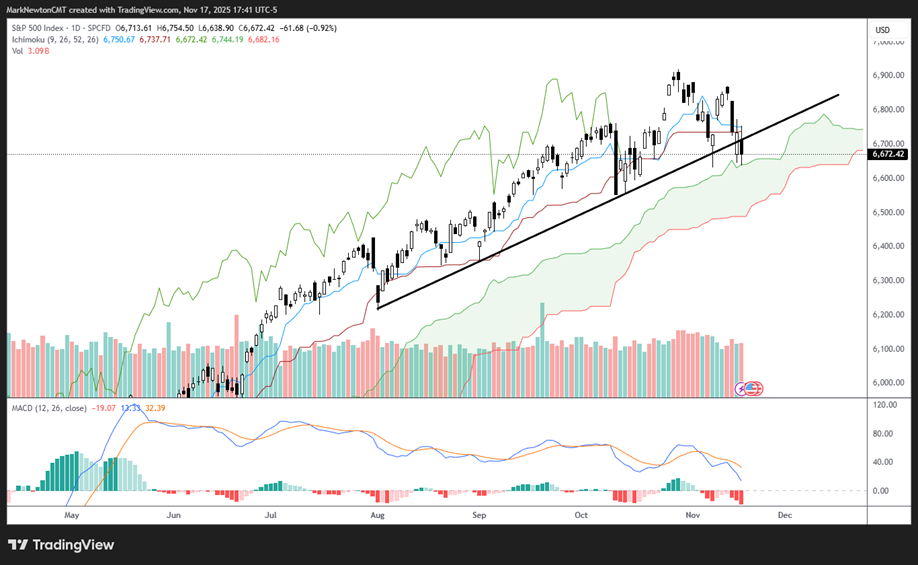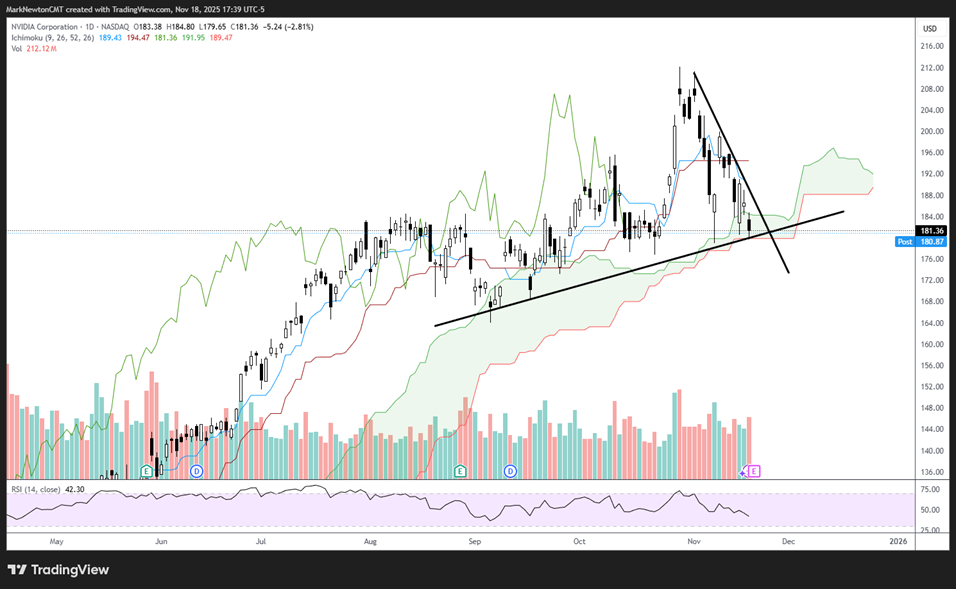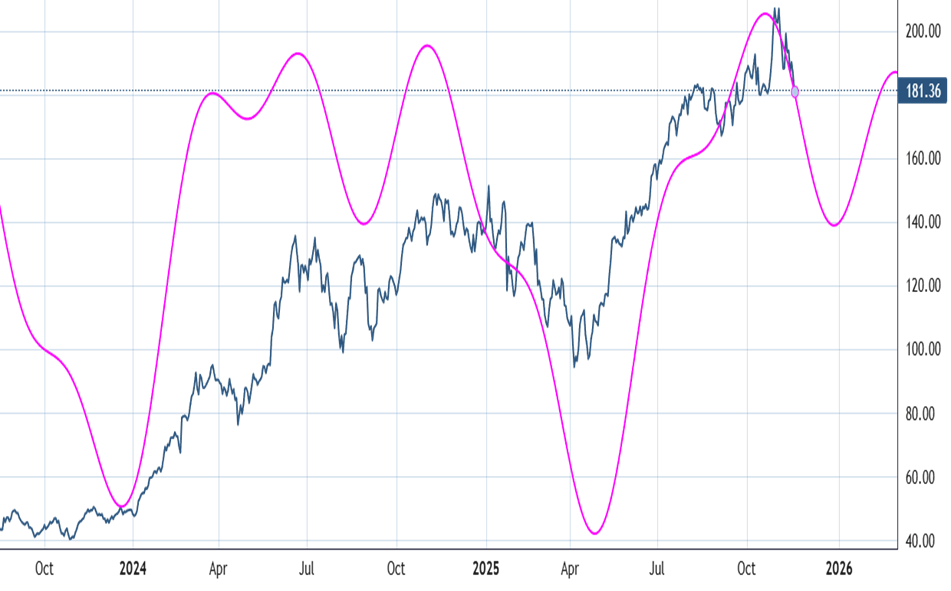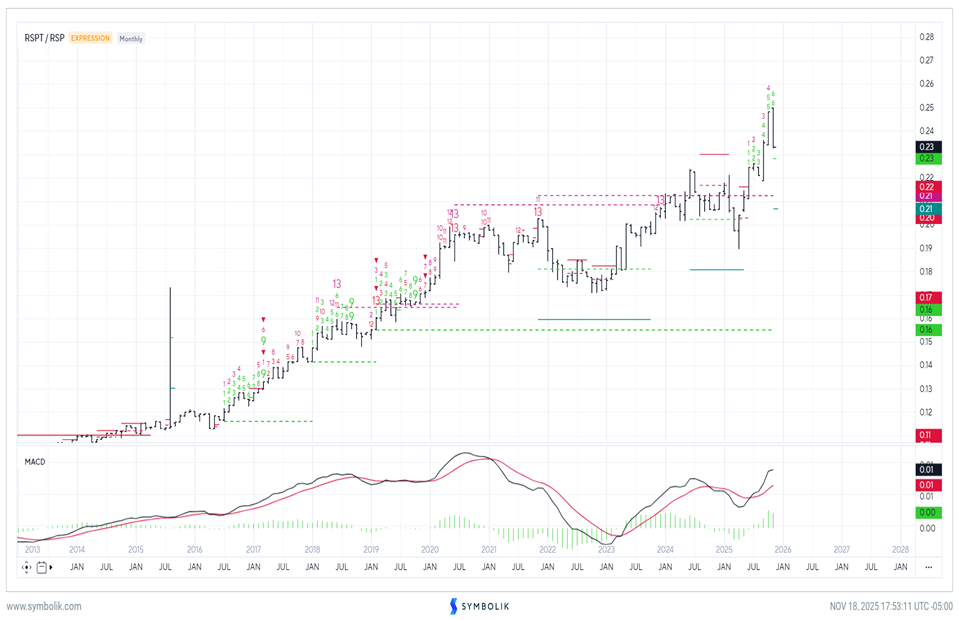US Equity trends remain choppy, but arguably have not broken down in a way that should give way to much more technical weakness. Both SPX and QQQ look to be stabilizing near key support, which could lead to a bounce this week if NVDA earnings do not disappoint. While many investors have started to turn more bearish, the technical trends cannot be considered bearish with prices above October lows in both SPX and QQQ. Furthermore, Equal-weighted SPX has also not broken down. While market breadth and momentum have been under pressure for the last few months, the combination of cycles bottoming, DeMark exhaustion starting to form, along with Elliott-wave patterns nearing completion, is a reason to buy dips into late November. Overall, I am expecting a bounce vs. a breakdown in the days ahead. However, it remains paramount for a broad-based rally to start to get underway as December nears. Failure to mount a strong rally in December that helps to lift market breadth into year-end would likely prove to be a 1st Half 2026 problem. For now, I like using recent weakness to buy.
As daily ^SPX charts show below, ^SPX has pulled back to within striking distance of October lows. (QQQ has done this as well.) Market breadth proved to be flat on Tuesday’s setback, which should come as a bit of a relief for market bulls as the strength of the selloff looks to be waning. Yet, given that momentum continues to grow worse for this market, it’s imperative to mount a quick and strong rally in the days ahead.
Many market participants have commented that ^SPX has now broken its 50-day moving average (m.a.), and that this signals the start of a larger downturn. I do not feel it’s right to use 50-day m.a. as any kind of trading tool, but merely as a guide to market strength. The slope and/or percentage above/below 50-day m.a. have more practical meaning to me than a breakout or breakdown. Many who traded the markets back from 2022 can attest to the difficulty of making trading decisions when an index like SPX suddenly moves above or below its 50-day m.a. (It proved quite choppy and not really all that satisfying for Bulls nor Bears. Specifically, the period from late 2022 into mid-2023, along with most of 2024, proved to give a plethora of false signals on a break of 50-day m.a.)
So, despite daily (and now weekly) MACD being negatively sloped and SPX set to potentially record the worst November since 2008, what would be the possible reasons to be positive? I’ll try to make a few relevant points below:
- Technology does not seem to be broken, despite recent weakness. Trends in stocks like AAPL, GOOGL remain in good shape, and even NVDA, despite its recent weakness, has not really broken down.
- Broader ^SPX and QQQ trends can’t really be called bearish with prices above October lows.
- DeMark-based exhaustion is starting to form on ETFs like QQQ (240-minute chart). This would also be triggered in SPY, also on an early Wednesday move under 655.86, and SPY has now retreated down to its disqualified TDST line (also based on DeMark theory).
- Cycles in ^SPX seem to show a low in place by the first week in December (lasting through mid-January). If NVDA were to positively surprise with earnings on Wednesday, this might “kick into gear” early.
- Sentiment has gotten downright bearish again, with polls like AAII and Fear and Greed having registered high levels of bearish sentiment.
- Elliott patterns still look “corrective” (Overlapping wave structure, which is normally not conducive to thinking there has been a meaningful peak). This began in late October, so it looks quite different from the former selloffs, which started in early 2022 or early 2025.
However, it’s important to note that the deterioration in market breadth has gotten worse, not stabilized. Additionally, there remain many sectors that have not really been participating lately, which are important to the US Stock market (Financials, for example), that need to start showing more strength. Furthermore, some of the weekly cycles (which I’ll discuss in greater detail during next month’s 2026 Technical Market Outlook webinar) look bearish for the first Half of 2026- more on this later.
Thus, while I feel it’s right to buy dips in November for a push higher into mid-January, I’m not convinced that ^SPX has much upside right away above ^SPX-7000. Furthermore, on a rally into mid-January, some of my Technical work might begin to turn a bit more negative if/when breadth cannot recover in a strong fashion.
Thus, for now, it’s less about whether ^SPX bottoms right away into/after NVDA, but more that a few technical factors have come together to suggest markets lie near an attractive risk/reward area for a Holiday bounce back to highs. While this might not materialize right away, I suspect it’s not too far off and should happen at the latest in the first week of December. Bottom line, I don’t mind fighting the recent minor weakness of the past few weeks, given the ongoing health of the tech-heavy SPX and NASDAQ between now and Year-end.
However, as shown below, it’s going to be necessary to stabilize sooner rather than later, and it’s important to hold October lows. If that level is broken, then the odds shift for an early December low, and that might materialize at fractionally lower levels. However, the push up in December likely can help to repair the recent minor technical damage of the past few weeks.
S&P 500 Index

NVDA has pulled back to test November lows
It’s important to shed some light on NVDA’s technicals ahead of tomorrow’s earnings.
Daily charts going back since this past Spring show an uptrend still in place, which has turned a bit choppier in recent months.
NVDA’s pullback this month has brought the stock down to near “make-or-break” territory right near November lows.
Overall, technically speaking, NVDA still looks appealing to me to own ahead of earnings, given that its current price has not violated support, which has held over the last few months.
To have concern, price would require a close under $178.91 on a daily close and, more importantly, a weekly close. If this were to happen, then I anticipate a possible test of September lows near $164.
However, I’m not a fan of betting on more downside in a stock that has sold off to near support and seems to be trying to stabilize.
The act of exceeding its downtrend from early November (weekly close back over $191) could possibly help it mount a strong rally back to its highs into January.
Overall, given that NVDA is the largest weight within the broader US Equity indices, it’s important to keep a close eye on NVDA following its earnings tomorrow.
(In the interest of fair disclosure, I do personally own shares of NVDA, and am not planning on changing my position, regardless of earnings results.)
NVIDIA Corporation

NVDA cycle seems to turn back higher in December into February
Given that NVDA’s weighting within the ^SPX is the highest of any stock right now, it’s important to study its own cycle projection to see where this might be headed in the months to come.
This cycle composite, since 2022 (used to identify the shorter-term cycles at work), did in fact peak in October of this year and looks to bottom out in December.
This projection might appear a bit more negative than what the daily NVDA chart shows above, but it still suggests an upward bias from December into early next year.
Thus, regardless of tomorrow’s results, I am expecting some kind of relief rally. If it starts this week, then studying the pattern will be important to ascertain whether a lower low is possible in December.
For now, I remain positive on NVDA possibly rebounding, given its decline from $212 down to $181, which looks to be trying to stabilize. I’ll provide some additional insights once the results of its earnings are known on Thursday.
NVDA Cycle Composite

Technology still shows excellent monthly momentum relative to the Equal-weighted SPX despite this month’s pullback
For many investors who have given up on Technology, it’s important to point out that momentum remains quite strong in this sector, despite some November underperformance.
This monthly relative chart of the Equal-weighted Technology ETF (RSPT) vs. RSP shows a sharp drawdown this month.
However, the trend from earlier this year remains in very good shape following its early-year breakout, which helped to drive its outperformance into this past fall.
Monthly MACD remains positively sloped, and there aren’t any indicators of counter-trend exhaustion, which were apparent back in 2021. At the time, these coincided with a multi-year period of Technology underperformance into 2023. At present, I’m not certain it’s possible to make the same call, despite this month’s decline.
While stocks like ORCL, SMCI have certainly fared poorly over the last few weeks, others like WDC, AKAM, TER, DDOG, MU, and STX have acted just fine, all returning over 10% over the past rolling one-month return ending 11/18/25.
Additionally, big S&P Weighted stocks like AAPL remain in very good shape technically and have not broken down. Thus, while NVDA has certainly weakened a bit ahead of its earnings tomorrow, others have sprung to life to help Technology. I don’t see this as problematic for the Technology sector. However, on rallies back to new highs into early 2026, I would consider this not as appealing from a risk/reward perspective.
RSPT/RSP






